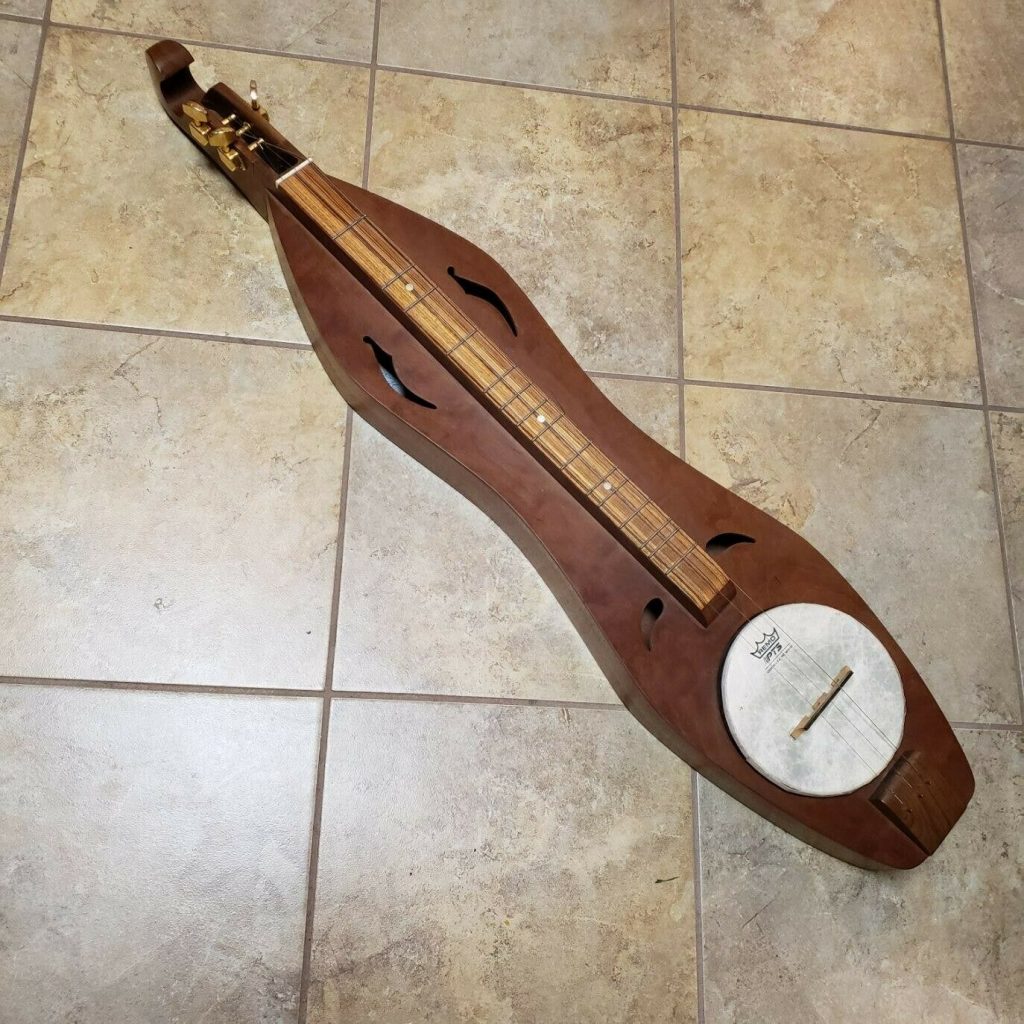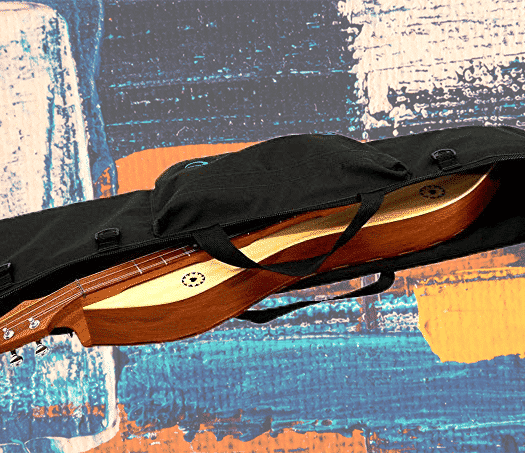The banjo dulcimer is a modified variant of the standard Appalachian dulcimer with unique acoustics.
Taking a step back, what exactly are dulcimers? Dulcimers are members of the zither family of instruments. They are stringed instruments characterized by their large shape and fretted strings. They usually have either three or four strings (although some instruments may have more) and they are fretted.
What is a Dulcimer?
Dulcimers have an ancient history, dating back to the Middle Ages in many parts of Europe. Derived from the the Latin word dulcis (“sweet”) and the Greek word melos (“song”), the dulcimer produces “sweet sounds.”
Dulcimers are typically played on one’s lap and can either be plucked like a guitar or played with a bow, as in the case of the mountain (or “Appalachian”) dulcimer. Hammered dulcimers, on the other hand, are typically played by using little hammers and have unique tuning patterns. Dulcimer guitars (or “dulcitars”) are a hybrid between acoustic guitars and traditional dulcimers.
The banjo dulcimer is a modified variant of the standard Appalachian dulcimer with unique acoustics.
What is a Banjo Dulcimer?
Banjo dulcimers are modified versions of the more widely recognized Appalachian dulcimer. A banjo dulcimer has a vibrating membrane attached to the dulcimer’s body, and this is what gives the instrument its characteristic banjo sound. It also alters the tone and volume produced when the instrument is played.
The banjo dulcimer can be a welcome accompaniment to singing. Its gentle acoustics means that it complements songs well, and it is especially good for use with playing melodies, harmonies, and chords.
In fact, the banjo dulcimer is considered to be easier to play chords than a generic guitar. Moreover, experienced dulcimer players may even be able to pull off classic musical pieces and more with the right skills and a mastery of the more complex finger arrangements.
A key benefit of the banjo dulcimer is ease of use and simplicity. Unlike other stringed instruments which can require significant time and skill to learn, the banjo dulcimer’s has a small number of strings. And this means that it is relatively simple to learn and master.
While more complex music can be played with it, it is most commonly used as an accompaniment. It is a great instrument for new music players – both young and old. And it’s certainly a unique instrument – be prepared with questions from curious onlookers!
History of the Banjo Dulcimer
Although the banjo dulcimer is a more recent invention, the dulcimer itself is actually a relatively old instrument. Historical records appear to indicate that the dulcimer has roots in the medieval period, although the exact date at which it was first developed is not clear.
Traditional dulcimer models are sometimes classified as transitional instruments, with later models classified as more pre-revival and revival.
How are Modern Banjo Dulcimers Made?
Modern banjo dulcimers are made following the same basic principles and rules as the Appalachian dulcimer. However, the primary difference between the banjo and Appalachian models is that of the vibrating membrane. By adding this to the body of the instrument, the acoustics produced are altered. And this gives the banjo dulcimer its recognizable sound.
Materials Used to Make Banjo Dulcimers
Typically, most banjo dulcimers are made using the same type of materials that common with traditional 18th century dulcimers – namely, they are made from wood. However, modern dulcimers are made from a selection of different woods in order to enhance the sound they produce.
The top of the sound box is usually made from a “tone wood”. These woods include spruce or cedar, both of which are popular materials for crafting dulcimers. Tone wood is particularly good for use with stringed instruments such as the banjo dulcimer. As its name suggests, “tone wood” enhances the tone produced by an instrument.
For the body of the instrument, hardwoods are generally more preferable. Hardwoods are used for the back, sides, and neck of the instrument. For example, maple is a good choice for some of the more structural aspects of the instrument.
Many experienced dulcimer builders continued to carry out the trade in America. Builders continue the tradition of using locally sourced wood in their instruments. Walnut, oak, cherry, and apple are used especially frequently with modern dulcimers.
How Many Strings on a Banjo Dulcimer?
Banjo dulcimers – and all dulcimers in general – usually have either three or four strings. Typically, each of these strings will vary in diameter between 0.01 inches and 0.026 inches. Some strings can be custom made to have a diameter outside of this range, though usually for specific tunings or playing styles.
Although the banjo dulcimer usually has three or four strings, they can have anywhere between three and six strings, depending on their design. Dulcimers with more strings will often have one or more double strung strings. These provide a higher pitched melody than the single strings.
As such, the exact sound produced by a banjo dulcimer will largely depend on the number and arrangement of strings it features.
Makers of Banjo Dulcimers
Despite their long history, dulcimers were first mass produced only recently in 1969. However, the modern market for dulcimers (and banjo dulcimers in particular) is still predominantly based on handmade instruments, built by skilled craftsmen.
Some of the most well known banjo dulcimer makers include:
- Doug Thomson – Doug Thomson has been making his range of hand crafted banjo dulcimers since 1980, with his instruments being dubbed “banjo-mers”.
- McSpadden Dulcimers – The company was founded in the early 2000s. As the name would suggest, they already specialized in dulcimer making at the time, and had been doing so since the late 1960s.
- Mike Clemmer – The “ban-jammer” instrument, a variant of the banjo dulcimer, was created by Mike Clemmer.
- Dennis DenHartog – Dennis DenHartog’s contribution to the banjo dulcimer industry included his solid frame instrument called the “banj-mo”. The instrument was first made available in 2001 and has been a popular model ever since.
These are just a few of the makers of banjo dulcimers. Indeed, there are many individual craftsmen and small local companies also making these unique instruments. Their affordability also makes them popular choices for many.
Things to Consider When Buying a Banjo Dulcimer
When it comes to buying a banjo dulcimer, there are a few things that you might want to consider. These are not exhaustive, of course, so always do your research before choosing one that’s right for you.
Budget
This one’s obvious. One of the first things to consider when buying a banjo dulcimer is cost. After all, it would be ill-advised to spend more than you can afford on a single instrument!
The banjo dulcimer itself is a relatively affordable instrument, thanks to its simple design without dramatic design features. However, the cost of the wood materials can impact the price of the banjo dulcimer, so this may be worth considering.
Occasionally you can find used dulcimers on eBay. For those lucky enough to find one, this may be the most cost-effective solution when starting out. Be sure to check the listing, as returns may not be an option.
Wood Choice
The quality of the materials and craftsmanship is a key driver on the performance of any acoustic instrument. Dulcimers have traditionally been made from locally sourced wood materials. This is a tradition that lives on to this day for many banjo dulcimer makers . Many use a variety of American-sourced woods to remain true to how they were historically built.
So, when looking for the best banjo dulcimer for your needs, take a moment to consider the quality of the materials used in its production. A dulcimers made from more modern materials – such as plastics – likely won’t provide the same user and listener experience as you might expect from a traditional wooden dulcimer.
Number of Strings
The string setup is another important consideration. Dulcimers can have between three and six strings, with high string models featuring doubled strings that give a different tone and sound.
So think about the level of skill you’re looking to develop, and the sound you want to create. Then pick a banjo dulcimer with the right amount of strings to facilitate this.
Final Thoughts on Banjo Dulcimers
The banjo dulcimer itself is a unique version of the traditional dulcimer and a relatively new creation. However, it has a rich and diverse history that is sure to intrigue. It has early origins as a simpler alternative to the violin. It is also less expensive that the violin, easier to make, and easier to learn.
However, that doesn’t mean the quality of acoustics it can provide is compromised. Indeed, the banjo dulcimer is ideal for music players of all levels, offering plenty of potential for use with many different songs and melodies. Its simple diatonic fret pattern makes it easy to learn and master. However, it can then be used in more complex ways to create powerful and impactful melodies as well.
This versatility, coupled with its pleasant aesthetic, means that it is an instrument which has a role in many pieces of music. Seeing its revival with folk music of the 60’s, the instrument can now be used in many roles. And it’s great for accompanying songs or teaching young children how to play a stringed instrument.
Not quite sure the banjo dulcimer is for you? For more traditional dulcimers, check out our reviews for the mountain dulcimer, hammered dulcimer, stick dulcimer, and dulcimer guitar.






